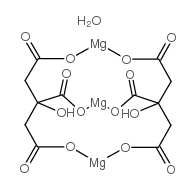120156-45-8
| Name | Magnesium hexafluoro-2,4-pentanedionate dihydrate |
|---|---|
| Synonyms |
EINECS 222-093-9
MFCD00036422 Magnesium citrate hydrate,Mg ca (dry wt.) |
| Boiling Point | 309.6ºC at 760mmHg |
|---|---|
| Molecular Formula | C12H12Mg3O15 |
| Molecular Weight | 469.13000 |
| Flash Point | 155.2ºC |
| Exact Mass | 467.97300 |
| PSA | 207.49000 |
| Vapour Pressure | 5.73E-05mmHg at 25°C |
|
Section 1: Product Identification Chemical Name:Magnesium hexafluoroacetylacetonate dihydrate, min. 97% CAS Registry Number:120156-45-8 Formula:Mg(CF3COCHCOCF3)2.2H2O EINECS Number:none Chemical Family:metal fluorobeta-diketonate complexes Synonym:Magnesium hexafluoro 2,4-pentanedionate
Section 2: Composition and Information on Ingredients IngredientCAS NumberPercentACGIH (TWA)OSHA (PEL) Title Compound120156-45-8100%no datano data Section 3: Hazards Identification Irritating to skin, eyes and respiratory tract. If inhaled or swallowed, this compound may cause fluoride Emergency Overview: poisoning. Early symptoms include nausea, vomiting, diarrhea, and weakness Primary Routes of Exposure:Contact with skin and eyes. Inhalation of dust. Eye Contact:Causes irritation and serious eye damage. Effects may not immediately appear. Causes irritation, with redness and pain. Soluble fluoride may be corrosive. Effects may not appear Skin Contact: immediately Inhalation of causes severe irritation to the respiratory tract, causing coughing, sore throat, and labored Inhalation: breathing. Ingestion:May cause salivation, nausea, vomiting, diarrhea, and abdominal pain. Irritating to skin, eyes and respiratory tract. Fluoride poisoning may cause nausea, vomiting, diarrhea, Acute Health Affects: weakness, coma, respiratory failure and cardiovascular collapse. Product contains fluorine which under certain conditions of use, decomposition, or metabolism, may generate Chronic Health Affects:fluoride ion, causing, nausea, vomiting, labored breathing, hypocalcaemia, deterioration of bone and tooth structure, kidney and liver damage. NTP:No IARC:No OSHA:No SECTION 4: First Aid Measures Immediately flush the eyes with copious amounts of water for at least 10-15 minutes. A victim may need Eye Exposure: assistance in keeping their eye lids open. Get immediate medical attention. Wash the affected area with water. Remove contaminated clothes if necessary. Seek medical assistance if Skin Exposure: irritation persists. Remove the victim to fresh air. Closely monitor the victim for signs of respiratory problems, such as difficulty in Inhalation: breathing, coughing, wheezing or pain. In such cases seek immediate medical assistance. Seek medical attention immediately. Keep the victim calm. Give the victim water (only if conscious). Induce Ingestion: vomiting only if directed by medical personnel. SECTION 5: Fire Fighting Measures Flash Point:not applicable Autoignition Temperature:none Explosion Limits:none Extinguishing Medium:carbon dioxide, dry powder or foam If this product is involved in a fire, firefighters should be equipped with NIOSH approved positive pressure Special Fire Fighting Procedures: self-contained breathing apparatus and full protective clothing. Hazardous Combustion andIf involved in a fire this material may emit toxic organic fumes. Decomposion Products: Unusual Fire or Explosion Hazards: No unusual fire or explosion hazards. SECTION 6: Accidental Release Measures Spill and Leak Procedures:Small spills can be mixed with vermiculite or sodium carbonate and swept up. SECTION 7: Handling and Storage Handling and Storage:Store in a sealed container. Keep away from heat and moisture. SECTION 8: Exposure Controls and Personal Protection Eye Protection:Always wear approved safety glasses when handling a chemical substance in the laboratory. Skin Protection:Wear appropriate chemical resistant gloves and protective clothing. Ventilation:Material may form a fine dust. If possible, handle the material in an efficient fume hood. If in form of fine dust and ventilation is not available a respirator should be worn. The use of respirators Respirator: requires a Respiratory Protection Program to be in compliance with 29 CFR 1910.134. Ventilation:Material may form a fine dust. If possible, handle the material in an efficient fume hood. Additional Protection:No additional protection required. SECTION 9: Physical and Chemical Properties Color and Form:white powder Molecular Weight:438.41 (474.44) Melting Point:no data Boiling Point:no data Vapor Pressure:no data Specific Gravity:no data Odor:none Solubility in Water:slightly soluble SECTION 10: Stability and Reactivity Stability:air and moisture stable Hazardous Polymerization:no hazardous polymerization Conditions to Avoid:none Incompatibility:Oxidizing agents and active metals Decomposition Products:Carbon dioxide, carbon monoxide, organic vapors, fluorinated organics and magnesium oxide. SECTION 11: Toxicological Information RTECS Data:No information available in the RTECS files. Carcinogenic Effects:No data available Mutagenic Effects:No data available Tetratogenic Effects:No data available SECTION 12: Ecological Information Ecological Information:No information available. SECTION 13: Disposal Considerations Disposal:Dispose of according to local, state and federal regulations. SECTION 14: Transportation Shipping Name (CFR):Non-hazardous Hazard Class (CFR):NA Additional Hazard Class (CFR):NA Packaging Group (CFR):NA UN ID Number (CFR):NA Shipping Name (IATA):Non-hazardous Hazard Class (IATA):NA Additional Hazard Class (IATA):NA Packaging Group (IATA):NA UN ID Number (IATA):NA SECTION 15: Regulatory Information TSCA:Not listed in the TSCA inventory. SARA (Title 313):Title compound not listed. Second Ingredient:none SECTION 16 - ADDITIONAL INFORMATION N/A |
